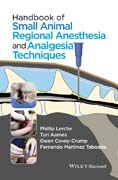
Handbook of Small Animal Regional Anesthesia and Analgesia Techniques
Lerche, Phillip
Aarnes, Turi
Covey–Crump, Gwen
Taboada, Fernando Martinez
This is a concise visual guide to the major techniques of regional anesthesia and analgesia for small animal practitioners, with complete coverage of the relevant physics, physiology, and pharmacology. Provides straightforward advice and easy–to–implement strategies for general veterinary practitioners without specialist training who want to incorporate regional anesthesia into their practice Features an accessible design with plenty of diagrams and photos and a convenient and robust spiral–bound format that lays flat for use during procedures Broken into sections which explain techniques by limb or body part and by species Details important anatomy (nerves, bones, and vessels), as well as possible side effects and complications INDICE: Chapter 1 Introduction1. Why provide regional anaesthesiaa. History of regional anaesthesia/analgesiab. Principles of the major techniquesi. Epidural/spinalii. Peripheral nerve blockadeiii. Regional infiltration iv. Topical applicationv. Intra–articular injectionc. Local anaestheticsi. Mechanism of actionii. Physico–chemical propertiesiii. Specific drugs1. Lidocaine, mepivacaine, ropivacaine, bupivacaine2. Duration of action3. Side effectsd. Additives to local anaesthetics i. Opioidsii. Alpha–2–adrenoreceptor agonistsiii. Ketamineiv. Adrenalinev. Bicarbonatevi. Hyaluronidase2. Equipmenta. Needlesb. Cathetersc. Peripheral nerve stimulators d. Ultrasonic imaginge. Differential pressure transducerf. Acoustic device3. Complicationsa. Local anaesthetic toxicityb. Adverse effects of technique4. Species differences and considerations5. Safe practicea. Gaining confidenceb. Making a planChapter 2 Practical application cutaneous innervation index1. Head2. Thoracic limb3. Pelvic limb4. Thorax5. Abdomen6. Perineum/tailChapter 3 Infiltration Blocks (8 diagrams, 4 photos)1. Infiltration for mass removal2. Soaker catheter/pain buster3. Intercostal blocks4. Intrapleural block5. Intraperitoneal blockChapter 4 Blocks of the head (12 diagrams, 6 photos)1. Retrobulbar2. Maxillary3. Mandibular (inferior alveolar)4. Mental (AKA middle mental)5. Infraorbital6. Major palatine7. Auriculotemporal and great auricularChapter 5 Regional anesthetic blocks of the limbs (7 diagrams, 10photos)H1 Thoracic limbH2 Brachial plexus (1 diag, 1 photo)H2 Paravertebral C6–T1 (1 diag, 2 photo)H2 RUMM (Radial/Ulnar/Median/Musculocutaneous) (1 diag, 2 photos)H2 Bier block (Staffieri 2013) (1photo)H1 Pelvic LimbH2 Femoral/Saphenous nerve blockH3 Inguinal approach (1 diag, 1 photo)H3 Lateral pre–iliac approach (caudal lumba plexus block) (1 diag, 1 photo)H2 Sciatic nerve block (Sacral plexus block)H3 Lateral approach (1 diag, 1 photo)H3 Parasacral approach (1 diag, 1 photo)Chapter 6 Epidurals/spinals (4 diagrams, 2 photos)1. Usesa. Abdominal painb. Thoracic painc. Hindlimbd. Perineum/Tail2. Techniquesa. Lumbosacralb. CoccygealChapter 7 Appendices1. Emergency Procedures2. Resources3. References
- ISBN: 978-1-118-74182-5
- Editorial: Wiley–Blackwell
- Encuadernacion: Rústica
- Páginas: 104
- Fecha Publicación: 01/01/2016
- Nº Volúmenes: 1
- Idioma: Inglés
- Inicio /
- /
